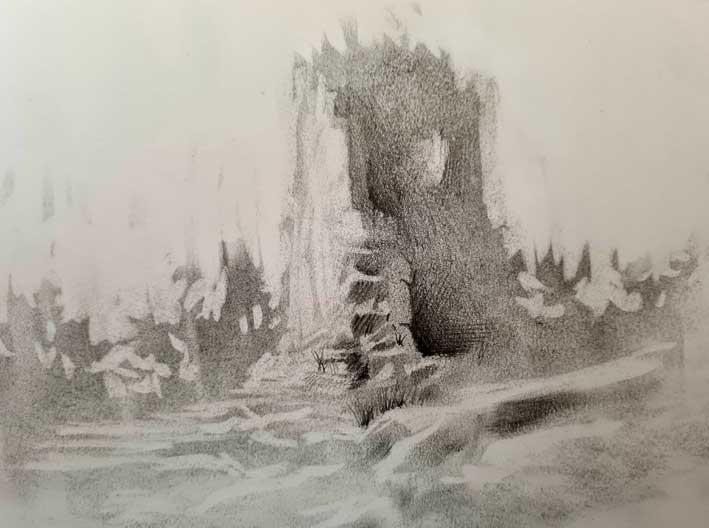'The Artistic genre of ruins interpreted as the depletion of moral and aesthetic values (Within a Maltese context)' forms part of a joint exhibition entitled 'Strada Stretta Occupy' by Students which is being held at The Splendid in Strada Stretta and Società Dante Alighieri in Old Bakery Street, Valletta. The works exhibited by Matthew Shirfield are part of his B.A Hons dissertation in History of Art and Fine Art with the Department of Art and Art History at the University of Malta under the supervision and guidance of Professor Giuseppe Schembri Bonaci. The works exhibited seek to understand the corresponding relationship that ruin has with moral and artistic values. Ruins have been studied throughout the years, raising several questions related to their purpose and role in society, methods of conservation, and aesthetics, amongst others. One of the interesting elements of a ruin is the way a society changes its perspective of what constitutes the latter due to changes in values. Hence, the perception guided by contemporary values influences the definition and role that a ruin plays in life as well as influencing the manner in which it is interpreted in Art. Ruins represent the continuous collapse of old and established orders, which are being interpreted as paralleling the twentieth century decline of moral and artistic values in the works exhibited.
Throughout the works presented within this exhibition, the artistic genre of 'ruin' was interpreted not only as its material manifestation, but, more importantly, as the depletion of moral and aesthetic values, with particular attention given to the Maltese context. This was done by exploring the various definitions of 'ruin' whilst discussing its different meanings. Through his research, Shirfield provided a debate on the moral value of art and juxtaposed it with ruins as can be seen in the triptych Moral Value Ruin. By incorporating the haunting screams of Francis Bacon and Edvard Munch, as well as E.L. Kirchner's hollow eyes, with the imagery of a pig to represent greed and gluttony, and the imagery of a bleeding heart to represent value, a relationship was created which conveyed the ruin of moral values. This was juxtaposed with the other works exhibited within the space to create a dialogue with the contrasting characteristics that make up ruin.

‘The Ruin I’, 2021, charcoal and pencil on paper, 15 x 21 cm.
Traditionally, as seen in the two side panels exhibited, a ruin is seen as a monument within the culture of a nation. It encapsulates the moral and artistic values of the time it was created. Therefore, by reducing these period constructions into ruin, it marks the corresponding collapse of the moral and aesthetic value that they beheld. These works served as a bridge between the moral value ruin represented through the triptych and the journey in search of authenticity. Mostly, but not only, in the 1960s Malta ignited the desire within artists to revert to the megalithic times of the nation in search for an authentic artistic language. This journey to the past is here interpreted through Dantesque imagery inspired by the Divina Commedia where the Medieval poet embarks upon a journey in search of purity, so as to challenge the contemporary decadence of Medieval Florence. This journey was interpreted in a series of drawings representing a few constructional ruins from the Maltese islands being visited by the two silhouetted figures representing Dante and Virgil. These works represent the values that a ruin encapsulates, and its value in serving as inspiration for future generations to progress.
The process of ruin occurs with or without the theoretical implications and connotations that humanity tries to impose upon it. To some extent the works presented in this exhibition are a type of ruin, as they deconstruct previous arguments and visual imagery, and, through re-formation, seek to form a new unity. Moreover, this exhibition seeks to convey the ruin and subversive acts that occurred during the twentieth century which unfortunately are being absorbed and normalized by a benumbed, twenty-first century society. In a recent article regarding the contemporary decadence of the age, Richard England stated that 'ethics and values have been carbonized; the promised dreams have turned to nightmares'. Hence, to negate this world of casual ruin, Giuseppe Schembri Bonaci argues that one has 'to reintroduce Beauty'. Beauty and order are, in his words, the 'determining factor[s]' and 'the silent call of the present'; the desired unity promised by the 'gift of destruction', the hopeful harmony pledged by ruin.
The works exhibited in 'Strada Stretta Occupy' by Students can be found in two locations: Società Dante Alighieri in Old Bakery Street, and The Splendid in Strada Stretta, Valletta. The works discussed here are exhibited at Splendid. The exhibition will be open until Thursday 22nd July. Opening times are Mondays to Thursdays between 6pm and 9pm, and Fridays and Saturdays from 7pm till 11pm.
Strada Stretta Occupy by Students is organized by the Department of Art and Art History, University of Malta, and The Strada Stretta Concept, as part of the Valletta Cultural Agency 2021 programme, in collaboration with the Società Dante Alighieri.